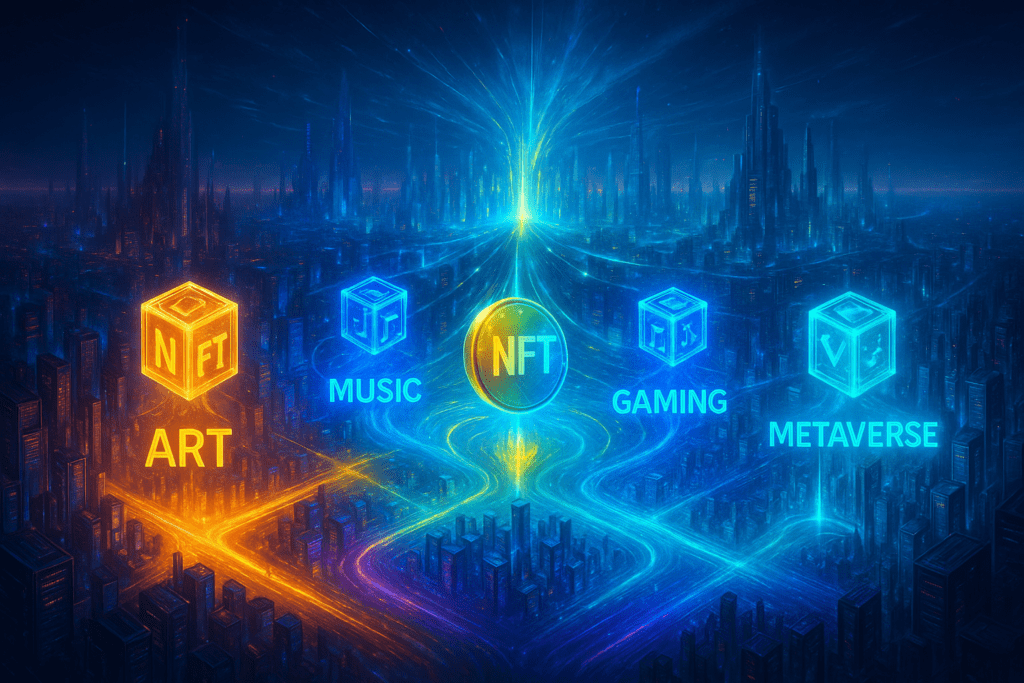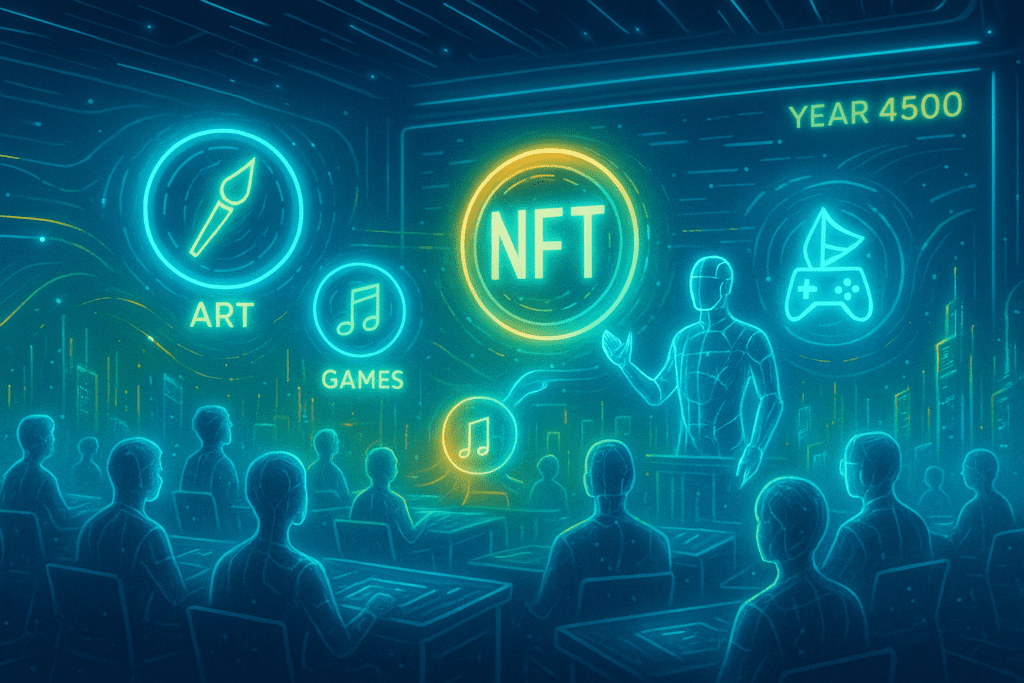NFT explained in simple terms — what they are, how they work, and why they matter in 2025. Learn digital ownership in plain language for beginners.
📘 Table of Contents
- Introduction: Why Everyone Talks About NFTs
- What Is an NFT?
- How NFTs Work
- What Makes NFTs Unique
- Different Types of NFTs
- How to Create, Buy, and Sell NFTs
- NFT Marketplaces You Should Know
- Why NFTs Have Real Value
- Common Misconceptions About NFTs
- The Future of NFTs: What Experts Predict
- Risks and How to Stay Safe
- Conclusion: NFTs as the Digital Ownership Revolution
Online advertising service 1lx.online
Introduction: Why Everyone Talks About NFT
In the past few years, the term NFT has exploded across headlines, art galleries, and social media feeds. From million-dollar digital artworks to collectible game items, NFTs have transformed how people think about digital ownership.
But what exactly is an NFT, and why are people spending real money on them?
This article breaks down everything — in plain, beginner-friendly language — so you’ll finally understand how NFTs work, why they matter, and how you can get involved.
“NFTs are not just pictures — they’re certificates of digital ownership written on the blockchain.”
What Is an NFT?
NFT stands for Non-Fungible Token. In simple terms, it’s a unique digital asset stored on a blockchain — a kind of digital certificate that proves ownership and authenticity.
While cryptocurrencies like Bitcoin or Ethereum are fungible (each coin is identical and interchangeable), NFTs are the opposite — each token is one of a kind.
An NFT can represent:
Online advertising service 1lx.online
- A digital painting or artwork
- A song or video clip
- An in-game item or collectible
- A piece of virtual land
- Even a tweet or meme
Once created, the NFT is recorded on the blockchain, where its history, creator, and current owner can be verified by anyone.

How NFTs Work
At the core of NFTs are smart contracts, self-executing programs running on blockchains like Ethereum, Polygon, or TON.
Online advertising service 1lx.online
When an artist or creator “mints” an NFT, a smart contract is generated that defines:
- Who created it
- What it represents
- Who owns it
- Royalties for future resales
Every transfer or sale of the NFT updates this contract, making ownership history permanent and transparent.
This technology removes the need for intermediaries — no galleries, agents, or auction houses.
“NFTs make digital ownership verifiable, tradable, and programmable.”
What Makes NFT Unique
NFTs combine scarcity, authenticity, and ownership in a single package.
- Scarcity — Each NFT is one-of-a-kind or part of a limited series.
- Authenticity — The blockchain verifies the creator and provenance.
- Ownership — Buyers truly own the asset, not just a copy of it.
Even though anyone can right-click and save an image, only one person owns the verified original NFT on-chain — like owning the signed painting versus a poster copy.
Different Types of NFT
NFTs go far beyond art — they now touch nearly every digital domain.
🎨 1. Digital Art
The most famous NFT category. Artists like Beeple and Pak have sold digital artworks for millions.
🎮 2. Gaming NFTs
In games like Axie Infinity or The Sandbox, players own characters, weapons, or land as NFTs.
🎟️ 3. Collectibles
From CryptoPunks to NBA Top Shot moments — limited digital collectibles that hold cultural value.
🎧 4. Music & Video
Musicians release exclusive NFT albums or concert tickets with built-in royalties.
🌍 5. Virtual Land & Metaverse
Platforms like Decentraland and Otherside sell parcels of virtual real estate.
🪙 6. Utility NFTs
NFTs granting access to communities, premium content, or physical events.

How to Create, Buy, and Sell NFT
Creating (or “minting”) an NFT is easier than it sounds.
🔹 Step 1: Choose a Blockchain
Most NFTs are minted on Ethereum, but cheaper alternatives like Polygon, BNB Chain, or TON are growing fast.
🔹 Step 2: Create a Wallet
Use non-custodial wallets such as MetaMask or TON Wallet to store and manage your assets.
🔹 Step 3: Select a Marketplace
Popular platforms include OpenSea, Magic Eden, and Getgems (TON).
🔹 Step 4: Upload & Mint
Upload your file, add details, set royalties, and pay a small fee (“gas”) to mint it on the blockchain.
🔹 Step 5: Sell or Trade
Once minted, list your NFT for sale or auction. Every transaction updates ownership on-chain automatically.
“Minting your first NFT is like signing your name into the digital history books.”
NFT Marketplaces You Should Know
| Marketplace | Blockchain | Description |
|---|---|---|
| OpenSea | Ethereum, Polygon | The world’s largest NFT platform |
| Blur | Ethereum | Marketplace for professional traders |
| Magic Eden | Solana, Bitcoin | Fast-growing multichain NFT platform |
| Getgems | TON | Telegram-native marketplace for TON NFTs |
| Rarible | Ethereum, Flow | Community-driven NFT platform |
Newer projects on TON blockchain are gaining attention, integrating NFTs directly into Telegram bots and mini-apps, making trading more accessible to millions of users.
Why NFTs Have Real Value
NFTs derive value from utility, scarcity, and social meaning — much like traditional collectibles or fine art.
Three main factors:
- Digital Ownership: Blockchain proves authenticity and control.
- Creator Economy: Artists and brands earn royalties forever.
- Community & Status: Exclusive NFT collections act as digital identity badges.
Just as early social media profiles defined online identity, NFTs define ownership in Web3.
“NFTs are the passports of the digital economy.”
Common Misconceptions About NFT
Let’s clear up the biggest myths.
❌ “NFTs are just JPEGs.”
→ NFTs are certificates of ownership that point to any digital (or even physical) asset.
❌ “NFTs have no real-world value.”
→ Many NFTs grant access to events, apps, or communities — merging digital and physical experiences.
❌ “NFTs are all scams.”
→ While scams exist, verified projects and reputable platforms dominate the legitimate NFT economy.
❌ “You need to be rich to start.”
→ Many NFTs are affordable or even free to mint; success comes from creativity, not capital.

The Future of NFT: What Experts Predict
The NFT market continues to evolve from speculation to utility-driven ecosystems.
Trends shaping the future:
- Gaming Integration: Play-to-earn models and in-game NFT assets.
- Real-World Assets: Tokenized property, luxury goods, and identity NFTs.
- Social NFTs: Integration into social media and messaging platforms.
- AI & Dynamic NFTs: Art that changes over time based on user interaction.
- Environmental Focus: Transition to eco-friendly blockchains (TON, Polygon).
Analysts predict that by 2030, NFT technology will underpin not only art and collectibles but also ownership of digital identities, tickets, contracts, and credentials.
“NFTs are not a fad — they’re the infrastructure of the new Internet.”
Risks and How to Stay Safe
Like all crypto innovations, NFTs carry risks:
1. Scams & Fake Collections – Always verify creators’ official links.
2. Volatility – Prices can drop quickly; avoid speculative hype.
3. Storage Risks – Use secure wallets; avoid leaving NFTs on exchanges.
4. Environmental Misconceptions – Newer blockchains are already energy-efficient.
Safety tips:
- Double-check URLs.
- Never share your wallet seed phrase.
- Research before buying.
- Keep assets in cold storage if valuable.
Conclusion: NFT as the Digital Ownership Revolution
NFTs mark the next step in the evolution of the Internet — from information to ownership.
They empower artists, gamers, musicians, and collectors alike to participate in a borderless digital economy where creativity has measurable value.
In plain words: NFTs turn imagination into assets.
Whether it’s a digital painting, a piece of music, or a collectible in your favorite game, NFTs give it identity, permanence, and worth.
“Web3 belongs to those who own their digital lives — and NFTs are the key.”
Our creator. creates amazing NFT collections!
Support the editors - Bitcoin_Man (ETH) / Bitcoin_Man (TON)
Pi Network (Guide)is a new digital currency developed by Stanford PhDs with over 55 million participants worldwide. To get your Pi, follow this link https://minepi.com/Tsybko and use my username (Tsybko) as the invite code.
Binance: Use this link to sign up and get $100 free and 10% off your first months Binance Futures fees (Terms and Conditions).
Bitget: Use this link Use the Rewards Center and win up to 5027 USDT!(Review)
Bybit: Use this link (all possible discounts on commissions and bonuses up to $30,030 included) If you register through the application, then at the time of registration simply enter in the reference: WB8XZ4 - (manual)
